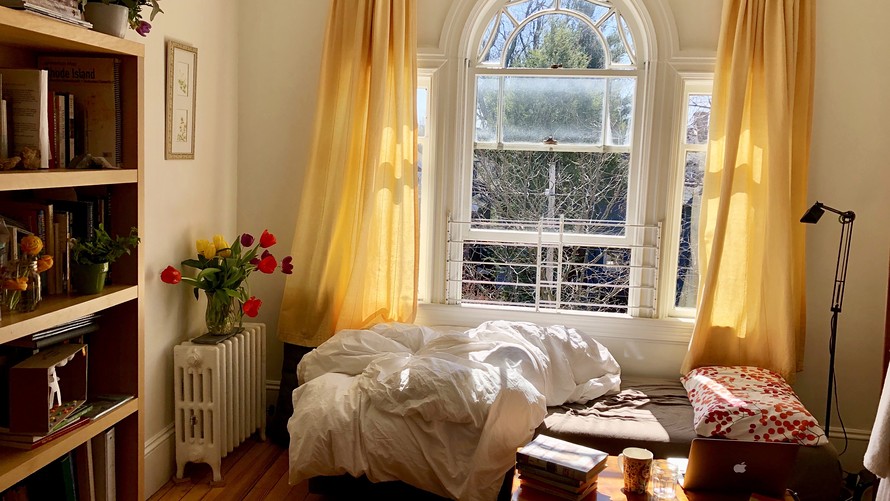PROVIDENCE, R.I. — A friend messaged me, then left two bottles of Gatorade by our back door. The following morning, another friend texted: “Bringing over homemade chicken broth!” She, too, left it at the door, along with a watercolor. “Wishing you a quick recovery,” she scrawled in pencil on the back.
Two evenings earlier, I had returned from a writing residency in Lisbon, Portugal, and developed a fever and intense body aches within hours of arriving home. I received a COVID-19 test the following morning at a drive-through testing site near Rhode Island Hospital.
Soon after, my brother called. Could he bring us a pot of bolognese sauce for dinner anytime soon? My husband and I mulled over the offer. He is a helper, one of those people you can count on to be there when you need it. But he, like me, finds it hard to accept help from others.
From my window, I watched people walking their dogs and jogging; parents pushing strollers. How would our friends and neighbors react? Would they fear us?
“Let’s practice saying yes to help,” I suggested. After all, I was now quarantined on the third floor of our home — and just when my husband thought he had regained his parenting partner following my 10-day trip, he found himself once again in sole charge of our two boys, ages 9 and 11. We had no idea how long this was going to last.
I thought of my brother’s offer. “Let’s accept,” I said. My husband surprised me by agreeing.
I received my positive test result the next morning: two weeks in isolation for me, and a mandatory minimum two-week quarantine for the rest of my family. At the time, there were fewer than 20 confirmed cases in all of Rhode Island. From my window, I watched people walking their dogs and jogging; parents pushing strollers. How would our friends and neighbors react? Would they fear us?
I was trained as a historian of Medieval Italy in the period of the Black Death, when the idea of quarantine as a social practice first emerged. In the late 1300s, cities with ports — the most important of which was Venice — began fighting the spread of disease by requiring arriving merchant ships to remain docked in port. This was initially a 30-day period, called trentino, from the Italian word for 30, but eventually became solidified in practice as quarantina, from the Italian word for 40.
For me, “quarantine” had always conjured images of these isolated ships teeming with rats, and of marooned sailors whose bodies were wracked by scurvy or the boils of bubonic plague. Did a 21st-century version of this await my family?
As I pondered the possibility, my phone pinged with a text. My brother had dropped off the bolognese, as well as chocolate-chip cookies his wife had made: salted on top, her specialty. One neighbor made an impromptu visit and left us groceries, while another left flowers and books. We accepted their offerings, always from a distance, with gratitude. Our ship was moored offshore, but few seemed deterred from rowing over to toss us sustenance from a safe distance.
My phone pinged with a text. My brother had dropped off the bolognese, as well as chocolate-chip cookies his wife had made: salted on top, her specialty.
The second day was the hardest. I was roiled with fever and intense body aches; my right leg thrummed from top to bottom and my back felt like it was in spasm. My head was on the verge of exploding and my cough had turned from dry to wet.
Amid all this, the offerings of friends, family and neighbors kept rolling in over the next few days: homemade bread, a bouquet of wildflowers and assortments of herbal teas, Portuguese rolls, cupcakes and chocolates, a “soup to raise the dead,” a pile of books, a rum cake that friends assured us they had “prepared with gloves.”
I had tested positive for a scary virus, and suddenly our whole world was reaching out.
Even old acquaintances were showing up. The assistant midwife from my younger son’s birth nearly a decade ago texted, “We’re getting a Whole Foods AMZN, -0.72% delivery tomorrow. Can we add anything for you?” She and her toddler are immunocompromised and live 20 minutes away. The pure generosity of her offer stunned me.
The Rhode Island Department of Health, which three weeks ago was barely on my radar, remained in constant contact. The female staffer who called to check my symptoms remembered me and addressed me as “honey.”
“I have never felt so cared for,” I told my husband.
 Alizah Holstein
Alizah Holstein All this, despite my “moderate” case of coronavirus. Although I was bedridden for two weeks, I did not experience the dreaded labored breathing or any extreme symptoms of this terrible disease. I was, however, exhausted, feverish and wracked with sinus headaches and body aches. I was separated from my children and husband and left to lie on a couch while others worked, like a Victorian woman with a fainting problem.
Things would not remain so simple. A week after I fell ill with COVID-19, my husband also developed symptoms consistent with the disease.
Things would not remain so simple. A week after I fell ill with COVID-19, my husband also developed symptoms consistent with the disease.
At first, we thought he was exhausted from all the work of preparing food, settling disputes and helping the kids navigate their new virtual school day, while simultaneously managing his own ongoing professional responsibilities. We surmised, too, that he was depleted from the emotional toll of reading about his hometown of Madrid and its terrible COVID-19 death toll; that waves of grief and worry for his aging parents, for his siblings who work in professions that bring them into close contact with the sick, had simply worn him down.
But we knew we had a problem when one evening, dinner tray in hand, he reached the top of the stairs and declared he needed to rest. My husband is the kind of person who climbs 4,000-meter mountains for fun. Not long ago, he climbed the Matterhorn, for god’s sake. Climbing the 29 steps to our third floor should not have been a challenge for him. It should not even have been a warm-up.
In the two weeks since I obtained my result, COVID-19 tests have become even harder to obtain. We will likely never know with certainty whether or not my husband has the disease. Difficult decisions have arisen: Who should take care of our boys? Which one of us should prepare food? Whose rest is more important? No one can enter our home — we are on our own. The image of the pestilent ship has begun to loom larger, and it takes work to push it away.
I called the health department for advice. “You both need to be in isolation, separately,” the staffer said. “And our kids?” I asked. There was a long silence. “I think you need to call your doctor,” she eventually said.
Difficult decisions have arisen: Who should take care of our boys? Which one of us should prepare food? Whose rest is more important?
The following day, my husband had a long conversation with his physician. Assessing who should do what, and when, seemed to involve complex mathematical equations involving probability, adjusted for age and sex, and weighed against average periods of contagion and recovery. The conclusion: I would take over most responsibilities, and my husband would prioritize getting much-needed rest.
During this more difficult period, offerings from friends, family, and neighbors have continued flowing in. At first, I marveled at how much people cared. I wondered whether we deserved it. But I have come to realize that the generosity we have experienced is about more than just us. In part because of lack of testing, and in part because our state is small, Rhode Island has relatively few confirmed cases of COVID-19. That number, though, is increasing: As of Tuesday, there were 488 positive or presumptive positive cases in the state. In my family’s circle, I am still the only person many know with a positive diagnosis.
At first, I marveled at how much people cared. I wondered whether we deserved it. But I have come to realize that the generosity we have experienced is about more than just us.
News of the spreading virus, and the many varieties of devastation it has provoked, have left all of us desperate to help. But it seems all we can do is wash our hands, stay at home and resist hoarding supplies. These actions, while vital, do not feel heroic. In the face of the coronavirus, we all feel small and more than a little helpless.
Many lament the isolation of modern American life. But in this moment, what I have seen from my window is a community waiting to be mobilized. People at home are looking for opportunities to do tangible good. For a while, my family was the object of their desire to help. Tomorrow, rightfully, it will be someone else.
I, too, have found ways of offering sustenance to others moored around me. In the past weeks, a handful of strangers from around the country — friends of friends — have called to talk about their symptoms, to compare them to what I experienced. “Do you think I have it?” they ask. They cannot access tests, and of course I do not know. All I can offer is understanding and reassurance, based on my own example, that perhaps they will be OK. The connection I feel with them, and the knowledge that we are all in this together, is real.
As the days pass, each one marked by increasingly grim body counts, we feel the ring around us tightening. COVID-19 is almost certainly spreading through our community. In coming weeks, the feeling of helplessness is likely to deepen. But, as an early COVID-19 case in my area, I have seen firsthand the power of a community poised to help.
I have the good fortune of saying that I will soon be through this. My ship will soon be permitted to dock, and to the extent allowed by social distancing, my family will disembark. I will soon be ready to row over some soup to others who need it.
The last few weeks have taught me that while the sustenance is important in itself, an offering on your doorstep is more than just food. It is a visible rendering of the rope that connects us to one another, the rope that stabilizes our lonely ships and gives us — singly and collectively — the courage to wait out this storm.
Alizah Holstein is a writer, editor, and translator. She holds a Ph.D in Medieval Italian history and is writing a memoir about being a historian of Rome.
This essay is part of a MarketWatch series, ‘Dispatches from a pandemic.’
 MarketWatch photo illustration/iStockphoto
MarketWatch photo illustration/iStockphoto div > iframe { width: 100% !important; min-width: 300px; max-width: 800px; } ]]>








